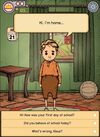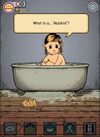Elin Festøy has a background as a journalist and documentary film producer. She was one of the first online journalists in Norway and has followed the technological media development and how it affects culture since the 90s. She is the creative director, producer and screenwriter of the game My Child Lebensborn, which she developed ahead of her scholarship period. The game is produced by Sarepta Studios and Teknopilot and in 2019 it was awarded the Games Beyond Entertainment prize at the gaming world's Oscar, the BAFTA Game Awards. Since 2018, she has been a part of CEFIMA, the film school's Center for excellence in education, as a research fellow.
My Child Lebensborn was your first game project, what drew you from documentary film to the game format?
- I like to explore new storytelling possibilities, but the choice of format must be motivated by the need to reach out to a certain audience and try to get them to understand something or change something. When I started making a documentary film about the Lebensborn children and their story, I quickly realized that this was the wrong format for the target group. We wanted 13-year-olds to learn that when the war is over, war victims are still being created because of the hatred towards the enemy's children. With a linear film about old people talking about the war, where there is nothing visually that tells us that this is really about children in the 50s, we wouldn't reach the 13-year-old. That's why the format became a mobile game.
- When we started, there were hardly any comparable games out there. It started as an experimental documentary project, and then it was fantastic that we made it happen. We managed to create something that hits the target audience and engages.

The character Klaus i My Child Lebensborn, a game which is described as "a dark Tamagotchi" (Photo: Sarepta Studios)
My Child Lebensborn tells the story of what happened to the children born to Norwegian mothers and German soldiers after World War II. The player becomes the adoptive parent of a child that they must care for and protect in a local community in the year 1951, when the hatred towards the German occupying power was still strong. The game presents the story behind the Nazis' Lebensborn program, the racial ideology, and what consequences it had for the children of war. The children that the player must show empathy and love when they do not understand why they are ostracized are called Karin or Klaus, and are based on the documentary stories of Norwegian Lebensborn children.
- The Japanese game Tamagotchi was an inspiration as it showed that giving care is a meaningful interaction. What happens if, instead of such a silly one-dimensional little being, you actually place a living child with a complex and true story into that screen? That's what we did, and with that insight we put a lot of work into creating a body language for that child and giving it personality, so that the character would be a truly "sticky character".
-We started early with testing and had a kind of playable prototype where you glue something together that you can go through interactively. We tested that on the target group. When we saw that 14-year-old boys became very concerned about being good parents, we realized we were on to something.
In the game, it is the emotional experience, and not points or challenges, that is the motivation for the player.
-There are a few games, but the number is increasing, that do something different from what a classic game does, which is to give you entertainment or puzzles and mastery. In My Child Lebensborn, you play through a story, but the interactions you make are not with the intention to win or get points. You want to get the feeling that you are capable of caring for the child. You can pat the child on the cheek and tickle it, and then the child reacts by laughing, and you get a good feeling. It's a gaming experience that gives you something else, an emotional experience.
For Elin, it is precisely this physical experience of the narrative that is one of the most exciting things about games and VR.
- The physical experience is also important in VR, since VR is immersion. Through a kind of physical presence you can gain insight into something that hasn't been told, and that is really exciting to explore.

The character Karin in My Child Lebensborn (Photo: Sarepta Studios)
Artistic research
In her artistic research at the film school, Elin dives deeper into themes that she did not get to explore within the framework of the My Child Lebensborn game.
-One of the themes that I didn't get to address neither in the film nor in the game I made about children of war, was the ethical problem, which is at the same time both incredibly strange and completely predictable: How can adults look at a child, a seven-year-old, and see an enemy and mistreat that child? How do the children end up as an image of the enemy and become an object of hatred? It is, after all, an "Us and Them" way of thinking. As soon as you have objectified and pinned a label on someone's forehead, you have made them less than human, and then it is legitimate to hate them or ostracize them.
Elin explores how a VR experience can make us aware of how we interact with the outside world and how we are affected by learned patterns of behavior and perspectives on the world.
- My Child Lebensborn is a simulation that invites you to walk a mile in someone else's shoes. Seeing the world from someone else's eyes is very good for empathy. But is it possible to walk a mile in your own shoes, and actually see with which eyes you see the world and how your upbringing and the culture you live in have given you a pair of glasses that does something with your field of vision? I want to explore this in VR, and challenge my participant by placing them in a context where you can make visible the way you see the world with a pair of glasses that you didn't even know you have on your nose. In my artistic research, I have gone through several different concept sketches to test what works.
What kind of scenarios did you test out?
-At first I thought that we must meet today's children of war, the children of the enemy's soldiers today. That topic became even more relevant while we were working on My Child Lebensborn and the issues surrounding children of ISIS soldiers was all over the media. The idea was to film these children so that you could meet them in VR, see them and make eye contact with them. The problem was that I thought too linearly and focussed too much on what I wanted to tell. In filmed VR I can to some extent control the gaze or the attention of the audience. You have points of interest that tell you how to focus and how to cut between scenes. It is nevertheless very easy to get distracted, get hung up on details and lose focus, if you as a participant don't get a role, but just have to stand there and watch.
- For each draft, I see weaknesses and strengths, and I learn how things work. A scene where you just stand there as a spectator can be fantastic if that is exactly what you want to convey. There are VR experiences where Holocaust survivors have been filmed telling their story, and then you want to lock the audience in, "now you're going to hear this story". Then it is part of the narrative mode you need, it is part of the message.
-The latest ideas I have worked on are that you as a participant enter a somewhat science fiction-like universe that is completely foreign to you, where your learned frames of reference have no meaning, regardless of what culture and background you have. We will show you how to interact with this place and make you aware of how you make decisions based on these glasses we have on our noses. It has been a long development process, starting from something very concrete and filmed and advancing towards something that is as abstract and as interactivity-based as possible.
In the development of commercial games and films, there is a necessary focus on the finished, polished product, while the artistic research fellowship at the film school has given Elin the opportunity to explore and focus on the process.
- I am grateful to be able to get an artistic research fellowship period to explore this field, which lies in the middle between classic games and documentary films, and where there is so much that is still untested. It is interesting to try to put into words the different perspectives and aspects of it, to understand what comes into this field and what is relevant. I see that many people are interested in this and I get inquiries from literature, film and gaming communities. This autumn, for example, I have been invited to speak for writers at the Bjørnson Festival, filmmakers at Nordic Panorama and game developers at the Game Developers Conference in San Francisco.
- We have a lot to learn from each other. Documentary filmmakers and journalists are very good at the editorial side of dealing with a true story and archival material, while the gaming industry is good at involving the player and giving them an experience, such as excitement, testing of skills and mastery. Including this element of truth, the humanistic element of genuine humanity, does something to the gaming experience, and we see more games introducing more ethical issues and dilemmas. It is an exciting development.
- There are so many possibilities and we have only just begun to poke into them. It can be compared to a library where the shelves for crime books are the only ones that are full, but all the other shelves must also be filled with stories. We need to fill new shelves and attract new target audiences to games.
(Article published 23.11.2021)
On June 30th 2022, the ph.d. program in Artistic Research in Film and related audiovisual art forms at the Norwegian Film School was formally approved by the Ministry of Education. The Artistic Research Fellowship program will therefore be phased out. The nine research fellows in the Artistic Research Fellowship program will be transferred to the ph.d. program and new ph.d. positions will be announced in the Fall of 2022. Read more about the new ph.d.-program here.





